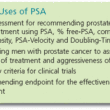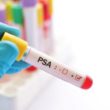Former President Biden’s Prostate Cancer Diagnosis Shines a Light on the Importance of PSA Testing

The news that former President Joe Biden has been diagnosed with a highly aggressive form of prostate cancer presents an opportunity to examine critical information that could help thousands of men avoid this life-threatening situation.
Biden was diagnosed after he had urinary symptoms and a growth (“nodule”) on his prostate gland on a digital rectal examination (DRE). This is unusual because a PSA blood test can usually diagnose prostate cancer up to 15 years before the cancer causes symptoms. He shared that his tumor is stage 4 and Gleason Score 5+4=9 (Grade Group 5). Stage 4 means that the cancer has spread from the prostate gland to other parts of the body – in his case, to the bones. The Gleason score is a grading system for prostate cancer that indicates its aggressiveness and rate of spread. The higher the Gleason score, the more aggressive the cancer. Gleason 9 is amongthe highest categories of Gleason scores. This grade and stage of prostate cancer is not curable.
Some have questioned how this advanced, aggressive prostate cancer remained undetected for so long, given Biden’s access to top healthcare, especially in a high-profile case like a sitting Former President Biden’s Prostate Cancer Diagnosis president. It has been reported that during the PSA testing era which began in 1991, the four previous sitting Presidents -Clinton, Bush 43, Obama, and Trump – all underwent PSA testing while in office.
Clinton championed PSA screening and made it more widely accessible by including it in Medicare’s preventive benefits at no cost to beneficiaries, beginning January 1, 2000. Clinton pledged that his administration would “… direct as many resources as possible to combating ”prostate cancer…, which he termed “…one of the greatest health threats…”men face. “For far too long, too little was known about prostate cancer, too little was said about it out of embarrassment and fear. And because of this, too little was done about it, ” Clinton said.
Before his recent diagnosis of prostate cancer, Biden had PSA testing only once in2014, when he was Vice President and 72years old. His medical team noted that they followed the then-accepted U.S. guidelines, which recommend against routine PSA tests for men aged 70 and older. They also stated that Biden had never been previously diagnosed with prostate cancer.
Before PSA testing was part of the standard prostate evaluation, former President Reagan underwent a urologic evaluation for urinary symptoms, followed by a transurethral resection (TURP) of the prostate for BPH. The prostate tissue removed showed no cancer.
For men over 70, the guidelines generally advise against routine PSA testing. Still, exceptions can be made based on individual health or concern. Prostate cancer in men over 75 is frequently diagnosed late due to low screening in the general population based on standard guidelines. Older age is associated with a greater likelihood of being diagnosed with more aggressive or advanced disease, as in Biden’s case, and older men face a higher risk of prostate cancer death.
Former President Biden also shared that his tumor appears to be sensitive to hormone therapy. Prostate cancers require male hormones, just as automobiles need gasoline or electricity to run. If the male hormone level is lowered, the cancers often go into a remission – a completely dormant state, sometimes for years and even decades. The fact that his cancer already appears to be hormone sensitive is a favorable prognostic sign. This means that it can be managed more like a chronic disease than like cancer, and that he may do very well for an extended period. The publicity about Biden’s prostate cancer diagnosis has re-ignited a decades-long debate concerning PSA screening guide-lines that remains incompletely resolved to date. The back story of this debate is summarized in the following article.



















